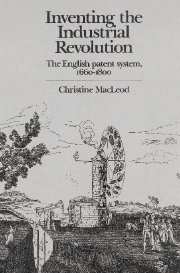Book contents
- Frontmatter
- Contents
- List of tables and figure
- Acknowledgements
- List of abbreviations
- Notes on style
- Introduction
- 1 Patents 1550–1660: law, policy and controversy
- 2 The later-Stuart patent grant – an instrument of policy?
- 3 The development of the patent system, 1660–1800
- 4 The judiciary and the enforcement of patent rights
- 5 The decision to patent
- 6 Invention outside the patent system
- 7 Patents in a capitalist economy
- 8 The long-term rise in patents
- 9 The goals of invention
- 10 Patents: criticisms and alternatives
- 11 A new concept of invention
- Notes
- Bibliography
- Index
2 - The later-Stuart patent grant – an instrument of policy?
Published online by Cambridge University Press: 28 October 2009
- Frontmatter
- Contents
- List of tables and figure
- Acknowledgements
- List of abbreviations
- Notes on style
- Introduction
- 1 Patents 1550–1660: law, policy and controversy
- 2 The later-Stuart patent grant – an instrument of policy?
- 3 The development of the patent system, 1660–1800
- 4 The judiciary and the enforcement of patent rights
- 5 The decision to patent
- 6 Invention outside the patent system
- 7 Patents in a capitalist economy
- 8 The long-term rise in patents
- 9 The goals of invention
- 10 Patents: criticisms and alternatives
- 11 A new concept of invention
- Notes
- Bibliography
- Index
Summary
Patents for invention survived the Commonwealth and Protectorate, reemerging in 1660 barely scarred by the experience. As this chapter will show, they were still regarded by the crown as rewards for service and as instruments for subcontracting its business – one of the resources at hand for administering the realm. But something had changed. The hostility towards monopolies that had helped destabilize the government of Charles I was still alive and menacing. The restored king could not afford to give it cause to surface. Charles II attempted to use patents covertly as grants of monopoly during the first few years of his reign, but apparently recognized that it entailed too great a risk. On the whole, allegations of unjust exercise of monopoly powers by patentees received swift investigation and, where necessary, action by the government. There was no regular fiscal exploitation of the patent system and little systematic patronage of courtiers, although they and office-holders received preferential treatment. Nor is there any evidence for an industrial policy such as Burghley's. Yet the government remained an interested party in the patenting of inventions until the early eighteenth century.
GOVERNMENT REVENUE
Despite a chronic shortage of funds during the first half of Charles II's reign and the recourse to heavy taxation and deficit finance to pay for William's and Anne's Continental wars, the patent system was only minimally exploited as a fiscal device. At least £70, and perhaps twice that amount, entered the coffers of the crown and the pockets of its officials every time patent was steered through the maze of writs, seals and docquets to enrolment.
- Type
- Chapter
- Information
- Inventing the Industrial RevolutionThe English Patent System, 1660–1800, pp. 20 - 39Publisher: Cambridge University PressPrint publication year: 1988

